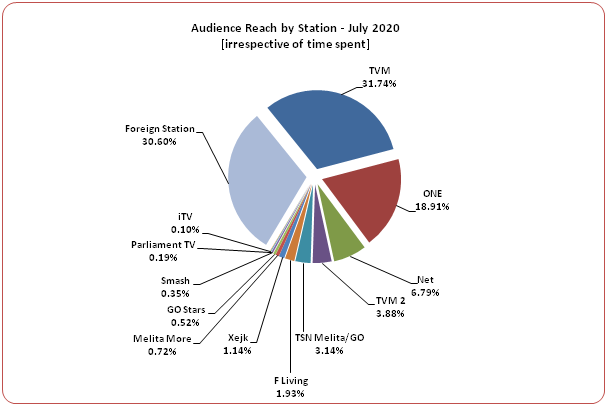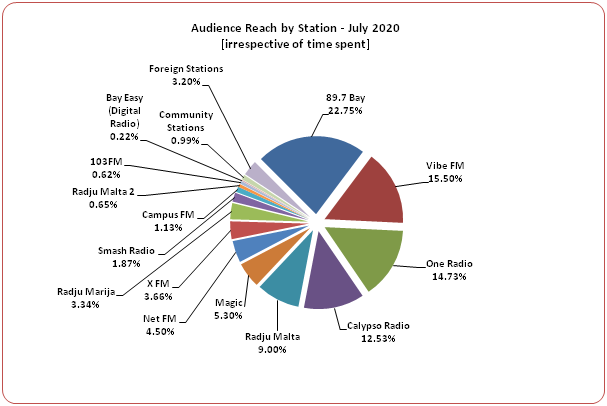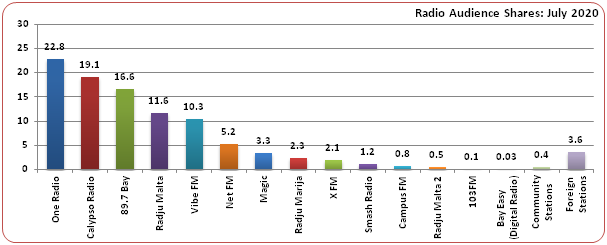Release: IMMEDIATE
Date: 8th October 2020
PR 13/20
July 2020 Audience Assessment
(Amended)
The Broadcasting Authority has released the audience assessment survey carried out in July 2020. The data for this assessment was collected during the month of July – a time when the steps to combat the Corona Virus pandemic were lifted.
Forty daily questionnaires were compiled by the NSO giving a total sample of 1,240 respondents with the youngest being 12 year olds while the eldest person contacted was 92 years old. Overall, this sample gives a margin of error of ±2.71%.
During July there was a marked decrease [>20.8% at 52.4%] in the amount of television audiences, but there was only a 2.2% decrease over a similar period last year [July 2019: 54.6%]. However, the average number of hours over all TV viewers was 2’24” minutes less than that registered at the previous assessment in March 2020 and 3’00” more than that registered last year during July 2019. Although audiences have decreased during July there was a marked increase in the number of reception services used by viewers - an 11.5% increase over the previous assessment period of March 2020.
On the other hand there was an increase of 7.4% [52.1%] in the number of audiences listening to radio stations over the previous assessment period of March 2020 [44.7%] and a minimal increase of 0.1% over that of a similar period last year [July 2019; 52.0%].
TELEVISION
As many as ≈237,300 [52.4%] of the population have watched TV during July. Compared to previous data, there was a significant decrease of 20.8% of viewers over the previous assessment period of March 2020 and a decrease of 2.2% over a similar period last year (July 2019: 54.6%). Although the largest ever percentage of viewers was registered during the previous assessment of March 2020 [68.9%] audience levels have returned back to their previous levels before the outbreak of Covid-19.
The average number of hours over all TV viewers amounts to 1.70hrs per viewer. This was 2’24” minutes less than that registered at the previous assessment in March 2020 [1.74hrs] and 3’00” more than that registered last year during July 2019 [1.65hrs]. Over the whole population aged 12 years and over, average viewing was at 1.20hrs which was 43’48” less than at the previous assessment of March 2020 [1.93hrs] and 6’00” lower than that registered for the same period last year [July 2019, 1.30hrs].
Audience Reach – Popularity:
Overall, while 67.75% of all viewers followed local stations, just more than a third of the population [34.97%] watched foreign content [including TSN Melita/GO, GO Stars, and Melita More]. Of the local stations, the top two stations [TVM and ONE] had audiences from all the demographical groups. Excluding foreign stations TVM and ONE ranked first and second respectively for all the age groups. The viewing for foreign stations was highest with those within the 12-20 age bracket [49.75%] and lowest with those over 71+ years old [19.56%].

In previous assessments it was repeatedly reported that the viewing of local stations was the highest with those over the age of 50 years while the viewing of foreign stations was higher with those from 12 to 50 years old. For the assessment of March 2020 viewing patterns had changed – the viewing of local stations was the highest with all the age groups and in all the districts. For this assessment period, there was a shift to previous patterns as those of July 2019.
Peak Audiences:
Peak audiences of the top three local TV stations were:
- TVM on Thursdays with 16.42%;
- ONE on Tuesdays with 11.08%;
- Net TV on Wednesdays with 4.03%.
TVM had the highest peaks amongst all stations for all the weekdays and exceeded those of foreign stations.
Average Audiences:
Taking the total average over a whole week [Monday to Sunday and excluding foreign stations] ONE attracted the largest average amount of viewers [0.888%] followed by TVM [0.753%], and Net TV [0.182%].
ONE has the highest average amongst all local stations on five weekdays - Saturdays [1.289% which was also the highest average amongst all local stations] followed by that of Tuesdays [0.941%], Fridays [0.928%], Sundays [0.926%], and Mondays [0.922%]. TVM had the highest average amongst all local station on two weekdays – Wednesdays [0.997%] and Thursdays [0.810%] – while its second highest was that of Tuesdays with 0.834% which was below that of ONE’s on that day [0.941%]. The highest average attained by Net TV was on Thursdays with 0.303%.
The viewing of foreign stations exceeded the viewing of any local station for all the weekdays with its highest being on Tuesdays at 2.041%.
Audience Share – Airtime:
The total airtime available for viewers was distributed as follows:

Excluding all those watching foreign stations [40.7%] TVM ranked first with 22.0%; followed by ONE with 18.6%; and Net TV with 4.5%. TV viewers watching foreign stations did so for an average of 2.26hrs while viewers watching TVM did so for an average of 1.00hr.
Favourite Programme Genres:
The most favourite programme genres named by respondents are: Local & Foreign News (23.0%); local Drama (14.3%); Discussion & Current Affairs (10.4%); Documentaries (9.8%); and Cultural/Educational programmes (8.9%).
The ranking of preferences has not changed much and there was little change in percentages over the previous assessment period of March 2020. Even when compared to a similar period [July 2019] differences were minimal except for ranking where Sports in July 2019 ranked 9th [5.0%] while during this period Sports ranked 6th [6.9%].
Television service:
The most common service for watching television is that of a paid subscription [88.8%] of both local media service providers [GO and Melita]; followed by IT based services [56.0% ]; 2.9% [≈13,000]who stated that they make use of the Free-to-air service, and 2.7% who make use of a satellite. Out of all the respondents who stated that they have a Free-to-air service, 55.2% [≈7,100] have an only Free-to-air connection while the rest make use of one or more of the other services available besides Free-to-air.
There was a marked increase in the number of services used –an 11.5% increase over the previous assessment period of March 2020. The highest increase was that amongst the 31-50 year olds [+22.4%] while there was a decrease of 4.7% amongst the 12-20 year olds. As a percentage over the whole population, the highest increase was that for Netflix [+5.8% - amongst all the age groups] while the highest decrease was that for Paid Subscriptions [-3.0% amongst all age groups].
RADIO
Irrespective of the amount of time which each respondent had spent listening to any particular radio station as well as irrespective of the number of radio stations they had followed the day before the interview, 236,200 persons (aged 12 years and over) listen to radio regularly. This is more than half the population – 52.1%. Compared to previous data, there was a 7.4% increase of radio listeners over the previous assessment period of March 2020 [44.7%] and a minimal increase of 0.1% over that of a similar period last year [July 2019; 52.0%].
When respondents were asked how many times they listen to radio during a typical week 70.2% of the population are regular radio listeners: 54.1% listen to radio every day while another 16.1% do so at least once a week. Only 9.4% of respondents stated that they never listen to radio while 18.1% stated that they are not regular radio listeners.
On average radio listeners have spent as much as 3.60hrs each. Compared to previous assessments, the amount of hours spent listening to radio has decreased by 4’128” over the previous assessment of March 2020 [from 3.67hrs to 3.60hrs] and has increased by 19’48” over that of a similar period last year from 3.27hrs [July 2019]. On a national average, the number of hours spent listening to radio stations [1.86hrs] has increased by 11’24” over that of the previous assessment period [March 2020: 1.67hrs] and has increased by 10’48” over a similar period last year [July 2019: 1.68hrs].
Audience Reach – Popularity:
Over all the listeners, 89.7 Bay has attracted the largest amount of radio listeners [22.75%], followed by Vibe FM with 15.50% of all listeners [≈37,000], ONE Radio [14.73%; [≈35,000], and Calypso Radio with 12.53% [≈30,000]. None of the stations were followed by respondents from all the demographic age groups.

Peak Audiences:
An indication of a radio station’s popularity is its highest amount of audiences obtained at any particular half-hour slot. ONE Radio had the highest peak amongst all stations on three weekdays – Tuesdays [6.470%], Fridays [4.923%] and Saturdays [4.703%] with that of Tuesdays being its highest.
Calypso Radio had the highest peak amongst all stations on two weekdays – Mondays [7.888%] and Sundays [4.605%], Mondays being its highest for the week.
Radju Malta had the highest peak amongst all stations on Wednesdays [5.252%] which was also its highest for the week.
89.7 Bay had the highest peak amongst all stations on Thursdays [4.653%] while its highest was that on Mondays with 6.710%.
Average Audiences:
Taking the average audiences attained by each station on each week-day, ONE Radio attained the highest total average amongst all stations [1.672%]; followed by Calypso Radio [1.402%]; 89.7 Bay [1.217%]; Radju Malta [0.855%]; and Vibe FM [0.758%].
ONE Radio had the highest average amongst all stations on four of the weekdays with its highest on Tuesdays [2.660%] followed by that on Thursdays [1.946%],Fridays [1.652%], and Saturdays [1.435%]. Calypso Radio had the highest average amongst all station on two days with its highest on Mondays [3.227%] followed by that on Sundays [1.298%], while Radju Malta had the highest average amongst all stations on Wednesdays [1.738%].
Audience Share: Airtime
The total airtime available for radio listeners was distributed as follows:

Overall, ONE Radio ranked first with 22.8% of all audiences, followed by Calypso Radio [19.1%], 89.7 Bay [16.6%], Radju Malta [11.6%], Vibe FM [10.3%], Net FM [5.2%], Magic [3.3%], Radju Marija [2.3%], and XFM [2.1%] while the rest had less than 2% of the audiences.
The radio listeners who have spent most time listening to their favourite radio station were those of ONE Radio [5.56hrs] followed by those of Calypso Radio [5.48hrs]; Radju Malta [4.59hrs]; and Net FM [4.16hrs]. On average all the radio listeners have spent as much as 3.60hrs listening to radio.
Compared to previous assessments, the amount of hours spent listening to radio has decreased by 4’12” over the previous assessment of March 2020 [from 3.67hrs to 3.60hrs] and has increased by 19’48” over that of a similar period last year from 3.27hrs [July 2019].
On a national average, the number of hours spent listening to radio stations [1.86hrs] has increased by 11’24” over that of the previous assessment period [March 2020: 1.67hrs] and has increased by 10’48” over a similar period last year [July 2019: 1.68hrs].
Radio Favourite Programme Genre:
Respondents were asked what their favourite radio programme is. While 22.4% named a programme genre, another 15.8% named a specific programme; while another 5.3% either said that they like all programmes on radio or “all” on a specific radio station.
Out of those who named a programme genre, the most quoted were Music programmes [60.0%], another 7.1% News & Newspaper Analysis, 5.0% Prayers & Religious programmes, and 3.2% Discussion programmes.
As much as 15.8% of the respondents named a specific programme which they like to follow. The most named programmes were those classified as “Morning Drive” programmes [49.5%], followed by “Daytime” programmes [34.75%], “Afternoon Drive” [11.24%], and “Evening Entertainment” programmes [3/26%]. Only 1.25% of the programmes named were for “Overnight” programmes.
DAB+ Radio:
12.2% of respondents have stated that they have a DAB+ radio-set – 49.7% of these have stated that they listen to their DAB+ radio-set for local stations only, another 30.5% stated that they listen to both local and foreign stations, while 9.4% stated that they follow foreign stations only. The rest [8.5%] have stated that they do not use their DAB+ radio-set while 1.9% did not reply.
The full version of the results of the survey can be downloaded from the Authority’s website.
Mario Axiak, M.B.A (Maastricht)
Research & Communications
8th October 2020
-----o-----
Click here for Press Release 13/20
Click here for the full Assessment of July 2020
Click here for previous assessments